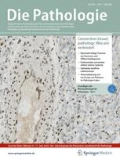Zusammenfassung
Bei 2 Frauen im Alter von 20 bzw. 41 Jahren wurden röntgenologisch als Zufallsbefund zystische Lungenveränderungen festgestellt, die sich in den Operationspräparaten histologisch als adenomatoid-zystische Lungenfehlbildungen vom Typ 1 erwiesen. Stellenweise fanden sich Verbände schleimbildender Zylinderzellen als epitheliale Auskleidung der Zysten und auch in deren Umgebung in Form herdförmiger tubuloazinärer Proliferate. In beiden Fällen bestand ein Übergang dieser Proliferate in ein bronchioloalveoläres Karzinom. In den Tumorzellen konnten keine Sulfomuzine mit Alzianblau bei pH 1 nachgewiesen werden, hingegen in den nichtneoplastischen schleimbildenden Zellen der Fehlbildung. In beiden Fällen war karzinoembryonales Antigen in den Zellen des bronchioloalveolären Karzinoms nachweisbar. Einige Zellen der Proliferationsherde waren gering CEA-positiv. Bei einer Patientin wurde die Karzinomdiagnose bereits intraoperativ mittels Schnellschnittuntersuchung gestellt und eine Lobektomie durchgeführt. Die andere Patientin, bei der zunächst nur eine Zyste entfernt worden war, mußte aufgrund des pathologisch-anatomischen Befunds reoperiert werden. Beide Patientinnen waren 8 Jahre nach der Operation rezidivfrei. In der Literatur finden sich bisher 5 Fälle von adenomatoid-zystischer Lungenfehlbildung bei Erwachsenen, 2 mal kombiniert mit einem bronchioloalveolären Karzinom. Über die Assoziation von zystischen Lungenveränderungen verschiedener Art mit malignen Neoplasien und ihren wahrscheinlichen pathogenetischen Zusammenhang ist mehrfach berichtet worden. Hier wird auf die mögliche maligne Entartung in adenomatoid-zystischen Lungenfehlbildungen bei Erwachsenen und auf die diagnostische Problematik hingewiesen.
Summary
Lung cysts were observed by chance in the chest radiographs from two women aged 20 and 41. In the surgical specimens the lesions proved to be congenital cystic adenomatoid malformation type 1. The cysts were partially lined by mucous cells. Also near the cysts there were circumscribed tubuloacinar proliferations of mucous cells. In both cases a transition into a bronchioloalveolar carcinoma was seen. Histochemically no sulphomucins could be demonstrated by means of an alcian blue pH 1 reaction in the tumor cells, but was demonstrated in the non-neoplastic cells of the malformation. In both cases CEA was demonstrated in the tumor cells. Some cells in the tubuloacinar proliferations were weakly CEA positive. In one patient the diagnosis of carcinoma was made by intraoperative frozen section and a lobectomy was performed. The other patient had first only a resection of her cystic lesions and had to be reoperated because of the results of the pathological examination. Both patients had no recurrence in the 8 years following the operation. In the literature we found 5 cases of congenital cystic adenomatoid malformation in adults. In 2 cases there was also an associated bronchioloalveolar carcinoma. Several reports exist on the association of different kinds of cystic lung lesions and malignant tumors and their possible pathogenetic relationship. In this paper we draw attention to the development of malignant neoplasia in congenital cystic adenomatoid malformation in adults and its diagnostic problems.
Author information
Authors and Affiliations
Rights and permissions
About this article
Cite this article
Morresi, A., Wöckel, W. & Karg, O. Adenomatoid-zystische Lungenfehlbildung bei Erwachsenen mit assoziiertem bronchioloalveolärem Karzinom. Pathologe 16, 292–298 (1995). https://doi.org/10.1007/s002920050105
Issue Date:
DOI: https://doi.org/10.1007/s002920050105

